
94% of researchers rate our articles as excellent or good
Learn more about the work of our research integrity team to safeguard the quality of each article we publish.
Find out more
ORIGINAL RESEARCH article
Front. Agron., 05 June 2024
Sec. Climate-Smart Agronomy
Volume 6 - 2024 | https://doi.org/10.3389/fagro.2024.1388823
Introduction: Sorghum is emerging as a viable crop option to increase food production under changing climate due to its resilience to drought and marginal soils. Appropriate planting date, crop cultivars, type of tillage and rotations, under contrasting climatic conditions, could make significant contribution on the effective management of sorghum under changing climatic conditions. A short-term study was carried out to investigate the effects of planting date, crop cultivar, tillage type and rotations on the growth and primary nutrient uptake of sorghum in contrasting climatic regions.
Methods: The study was conducted in Free State - (FS) and KwaZulu Natal (KZN) Provinces of South Africa over two seasons (2020/21 and 2021/22). The two cultivars (Pan8816 and Macia) were sown in December (PD1) and in January (PD2) under conventional tillage (CT) and no-till (NT) and with two rotations (Sorghum-Cowpea-Sorghum and Sorghum-Sorghum-Sorghum) resulting in 2×2×2×2 factorial experiment.
Results and discussion: In KZN, in both the first (2020/21) and second (2021/22) seasons, the effects of all the factors, except cultivar in the second season, were not significant on yield, and uptake of nitrogen (N), phosphorus (P) and potassium (K). In the second season, Pan8816 (4.40 t/ha) produced 3.3 times higher yield than Macia (1.32 t/ha), and took up higher N, K and P. In FS, the early planted sorghum (1.15 t/ha for season one; 3.39 t/ha for season two) had significantly higher yield than late planted sorghum (0.434 and 0.91 t/ha for seasons one and two, respectively). Furthermore, the early-planted crops took up higher N, K and P than when planted late, while Pan8816 took up 1.74 times more P than Macia. Plants grown under CT (2.61 t/ha) produced significantly higher yield than under NT (1.70 t/ha), with plants under CT taking up significantly more K than those grown on NT. These findings suggest that in the drier FS, early planting under conventional tillage, while in the wetter KZN, selecting the appropriate cultivar (PAN8816), are essential for sorghum grain yield, at least in the short-term.
The agriculture sector needs to produce more food from less land and water resources to provide for a growing population with an increasing per capita income in an urbanized world (FAO, 2017) under the difficult conditions of a changing climate (Lal, 2013). Climate change poses direct and indirect threats to food security through its influence on soil properties, water resources, and crop production (Fischer et al., 1996; Gornall et al., 2010; Lal, 2013; Masipa, 2017). These effects include, but are not limited to, loss of SOC, reduced fertility and plant available water, the prevalence of pests and diseases, changes in the hydrological balance, and increased soil erosion (Gornall et al., 2010; Lal, 2013). According to Lal (2013), agriculture is vulnerable to changes in climate, and projections point toward challenging times for farmers and land users, especially those in the developing world, especially sub-Saharan Africa (SSA) (Lal, 2019). It is therefore important to develop agricultural technologies and strategies that minimize the effects of climate change and can enhance and sustain soil productivity levels under adverse climatic conditions. This can be achieved through the selection of the appropriate crops to be grown under systems modified to suit the prevailing conditions in a particular region.
Conservation agriculture (CA) continues to be promoted as a suitable strategy that can ensure improved and sustainable production levels without compromising the environment and exacerbating land degradation (Aziz et al., 2013; Busari et al., 2015). In essence, CA entails the integrated management of available natural resources and other inputs to maximize efficiency (Choudhary et al., 2016) through minimal soil disturbance, permanent soil cover, and crop rotations (Hobbs et al., 2008). For maximum benefits to be realized, all the three principles of CA must be applied simultaneously. When applied appropriately, CA improves soil porosity, which in turn reduces runoff and erosion hence enhancing biomass production. CA can increase yield by up to 56% compared to conventional tillage due to increased soil organic matter and reduced evapotranspiration (Thierfelder and Wall, 2012; Wakindiki et al., 2018). However, smallholder farmers often struggle to maintain the requisite amount of crop residue for soil cover due to competing uses. Moreover, most soils under smallholder farming are too poor to support optimum biomass production. However, the inclusion of crop rotation in no-till systems may boost biomass production thus ensuring the retention of optimum levels of residues, which may increase yield.
While it is generally agreed that conversion from conventional tillage to no-till has potential to increase crop productivity, its effectiveness is influenced by soil and climate factors. For instance, Toliver et al. (2012) analyzed data from 442 paired tillage experiments across the United States, examining six crops and various environmental factors such as geographic location, annual precipitation, soil texture, and time since conversion from tillage to no-till. The results indicated that no-till generally resulted in similar or higher yields than conventional tillage for sorghum and wheat. However, environmental factors influenced yield variations between the two tillage methods for other crops. Moreover, no-till tended to produce similar or greater yields than conventional tillage in warmer and more humid regions with loamy soils. Conversely, in drier regions with sandy soils, no-till yields were often lower than conventional tillage yields. This suggests that CA may be less beneficial on sandy; however, there is not sufficient evidence on this in South Africa. Moreover, the effects of CA may be mediated by environmental conditions and cropping systems. Therefore, this study aims to show that no-till can be a viable and beneficial agricultural practice, particularly for certain environmental conditions and crops particularly sorghum, which has attracted significant interest due to its resilience to harsh conditions.
Due to climate change, areas that are currently suited to maize in the African savannah may in the future transition to being suitable for sorghum (Lal, 2013). Summer crop production in South Africa is shifting from current production areas due to changes in rainfall and temperature regimes (Weepener et al., 2014). Sorghum thrives on low fertility soils with limited inputs for food and industrial use in breweries, production of animal feed, and as feedstock for biofuel production (Meki et al., 2013; Ikazaki et al., 2020). Moreover, sorghum is the fifth most important cereal crop after wheat (Triticum aestivum), rice (Oryza sativa), maize (Zea mays) and barley (Hordeum vulgare) (Bakari et al., 2023) with high tolerance to heat and drought. The crop can remain dormant during dry periods (Pinzi and Dorado, 2011). During the period 1998 to 2020, 58–64 Million tons of sorghum was grown on 43.2 Million hectares of land globally, which equates 6.4% of total cereal growing land and 2.7% of total cereal production (Bakari et al., 2023).
Despite this huge potential, there is a critical knowledge gap. Very few studies have reported the performance of sorghum under CA across diverse environments and soils particularly sandy soils in South Africa. Although South Africa is traditionally a maize growing nation, climate change suggests that the baseline could shift toward drought tolerant crops such as sorghum as a coping mechanism (Soga and Gaston, 2018). Adapting sorghum-planting dates to synchronize with potential shifts in rainfall and temperature patterns, which vary across seasons, has been proposed as an adaptation strategy. However, there is little evidence regarding the effectiveness of this approach in South Africa. To address this gap, this this study aimed to compare the effects of growing two sorghum cultivars on two different planting dates and two tillage practices on sorghum growth, nutrient uptake and yield in two areas with contrasting soil and climatic conditions over two seasons. This study will provide valuable insights for optimizing sorghum production under CA in South Africa.
The study was conducted in Houtnek village (-29.0264; 26.8014) in Thaba Nchu, Free State and in Qongqo village (-28.0434; 31.6183) near the town of Nongoma, Kwa-Zulu Natal provinces, South Africa. The town of Thaba Nchu forms part of the Mangaung Metropolitan Municipality together with Bloemfontein and Botshabelo. The town is located at 1531m above sea level and receives approximately 692 mm of rainfall annually with an annual average temperature of 15.2 °C (Muthelo et al., 2019). The predominant farming activities are livestock (cattle and sheep) production and to a lesser extent cropping (oil seed crops). The area is characterized by duplex soils of the Valsrivier form, which translate to the chromic luvisol in the word reference base (WRB) for soil resources classification (van Huyssteen, 2020). These soils typically have dark brown to reddish brown topsoil and moderate to strong structured subsoil (Land Type Survey Staff, 1973–2004). The area is dominated by the Highveld grassland vegetation.
Nongoma is one of five towns that constitute the Zululand District Municipality. Annual rainfall in the area is reported to range from 800 to 1000 mm due to variation in topography, and the average temperature ranges between a minimum of 4 °C to a maximum of 20 °C (ZDM, 2018). Soils in the area are of the Swartland form (Protocalcic haplic luvisol in WRB) (van Huyssteen, 2020) with dark brown to grey topsoil transitioning to a moderate to strong blocky structured subsoil on weathering rock (Land Type Survey Staff, 1973–2004). The vegetation is described as the Natal lowveld bushveld. The major agricultural practices in the area livestock and cropping activities mainly beans and maize. The climatic characteristics of the two sites are presented on Table 1.
Soil samples were collected from 0–20 cm depth at each site for initial characterization prior to land preparation. The soil analysis results were used as a guide for fertilizer application recommendations. Soil pH and EC was measured in a 1:1.25 soil: water suspension using a laboratory pH meter and particle size distribution by the hydrometer method (Beretta et al., 2014). Essentially a soil-water-calgon suspension was used to separate particles of different sizes based on their settling velocity as determined by Stoke’s law. Total N was determined by dry combustion using a Leco CN-2000 analyzer (Wright and Bailey, 2001).
The 1M neutral ammonium acetate method (Van Reeuwijk, 2002) was used to determine CEC. A 1M ammonium acetate solution (NH4OAc) at pH 7 was used to extract the cations from the soil samples and the solution was shaken for two hours and centrifuged to separate the liquid and solid phases and analysis of cations was done by inductively coupled plasma-optical emission spectrometry (ICP-OES). The CEC was determined as the sum total of the determined cations. The determination of soil organic carbon followed the Walkley-Black method (Wang et al., 2012), where soil organic matter was oxidized with 1N potassium dichromate in the presence of sulphuric acid and the percentage amount of organic carbon calculated from the amount of dichromate remaining after titration with ferrous sulphate.
Selected characteristics of the study soils are shown on Table 2. Soils from both study areas show that the two sites were acidic, with KZN (pH 5.17) being more acidic than FS (pH 5.71) and the EC fell in the range of non-saline in both FS (3.0 mS/m) and KZN (7.79 mS/m) (USDA-NRCS, 2020). The KZN soil had more cations than the soil from FS. Total N was similar at KZN (0.13%) and & FS (0.11%), while the soil in KZN had more P (6.59 mg/kg) than the 2.88 mg/kg P in the FS soil. The soil in FS was sandy loam and had more sand (74%) and less clay (20%) than the soil from KZN, which was sandy clay loam and had 56% sand and 38% clay.
Sorghum was sown in 6 x 4.5 m plots with 1 m spaces between them and 4 m between the tillage systems and 2 m between planting dates resulting in each block being 28 X 24 m or 672 m2. Each plot consisted of 7 rows with 45 cm inter-row spacing. Mono-Ammonium Phosphate (MAP) was used as the pre-plant fertilizer and Lime Ammonium Nitrate (LAN) as the topdressing fertilizer at 3–4 weeks after planting. MAP was applied at a rate of 15.41 kg/block and LAN at a rate of 11.76 kg/block in FS. In KZN the application rates were 13.44 kg of MAP per block and 10.08 kg of LAN per block. The selective herbicide used was Sorgomil® Gold 600sc at 174.72 ml per block in FS and 201.6 ml per block in KZN, owing to the difference in texture between the 2 sites. Cypermethrin 200 EC was applied for the control of stalk borer at 23.5 ml per block and Decis® forte for the control of armyworm at a rate of 4.032 ml per block. The herbicide SLASH PLUS 540 SL was used at the start of each season for the control of perennial weeds at least 7 days prior to plant at a rate of 83.36 ml per block.
The two cultivars of sorghum used in this study were the bronze-grained, medium to late maturing PAN8816, known to be highly resistant to leaf disease and head smut and the early to a medium maturing open-pollinated variety (OPV), Macia. The common characteristic of the cultivars is that they are both low tannin, semi-dwarf hybrids.
The experiment was laid out in completely randomized block design with a strip-strip-split-plot treatment layout (Gomez and Gomez, 1984) and replicated three times. The factors of tillage and planting date were assigned to the vertically and horizontally arranged main strips. The two vertical strips were divided between conventional tillage (CT) and no-till (NT) while the horizontal strips were randomly assigned to early planting (December) and late planting (January). This vertical – horizontal arrangement of the strips resulted in intersection plots, which were split in two for the assignment of the two crop rotations, sorghum –sorghum-sorghum (S-S-S) and sorghum –cowpea-sorghum (S-C-S). The rotations were further split in two to accommodate both cultivars (PAN8816 and Macia) used in the trial. This resulted in 16 treatment combinations that were replicated three times. The field layout is visually depicted in the graphic below (Figure 1), showing a single block out of the total of three.
The following parameters were measured at the end of each season, during the months of May and June in 2021 and 2022, respectively. Plant height was determined at harvest (end of the season) using a graduated rod from the bottom the highest leaf. Plants that fell within the boundaries of a 4 m x 3 m (three middle rows) net plot were harvested at the end of the growing season to determine grain yield. The harvested panicles from each plot were threshed and weighed to determine yield. At the end of the season, leaves were taken from three random plants (same plants as for plant height) for leaf tissue analysis for nitrogen, phosphorus and potassium following the method of Zekri et al (2015).
The field trial was made up of 2 planting dates, 2 tillage systems, 2 cultivars and 2 rotations making the experiment a 2×2×2×2 factorial. The study was replicated three times and laid out in three blocks. The data from the field trial was subjected to Analysis of variance (ANOVA) and mean separation performed using least significant difference (LSD) at a confidence interval of 95%. The analysis was performed using JMP Pro Version 17 (JMP Statistical Discovery LLC, 2022).
Yield parameters, panicle length and 1000 seed weight did not show significant treatment effects in FS. The three-way interaction effect of planting date, tillage and sorghum cultivar did not have significant effects (p>0.05) on plant height in the first season. Only the tillage × cultivar interaction effects, and the main effects of planting date and cultivar significantly (p<0.05) affected plant height in FS. Greater plant heights were observed in early (131 cm) than late (110 cm) planted crop, PAN8816 (125 cm) than Macia (116 cm), in the first season, and the trend was the same in the second season. Under NT, Pan8816 had the significantly taller plants than the Macia both when planted early or later (Figure 1), while under CT, the difference was only observed when planted late (Figure 2). The only difference in plant height between the tillage systems was for Macia, when planted early, where CT had taller plants than NT (Figure 2). Under NT, the sorghum-cow pea-sorghum rotation resulted in significantly shorter plants than the sorghum-sorghum-sorghum rotation, under NT but not CT, when planted early but not later (Figure 3). When planted early, there were no significant differences between the rotations irrespective of tillage system (Figure 4). However, when planted late, the sorghum-cow pea-sorghum rotation resulted in significantly taller plants than the sorghum-sorghum-sorghum rotation, for PAN8816 but not Macia (Figure 4).
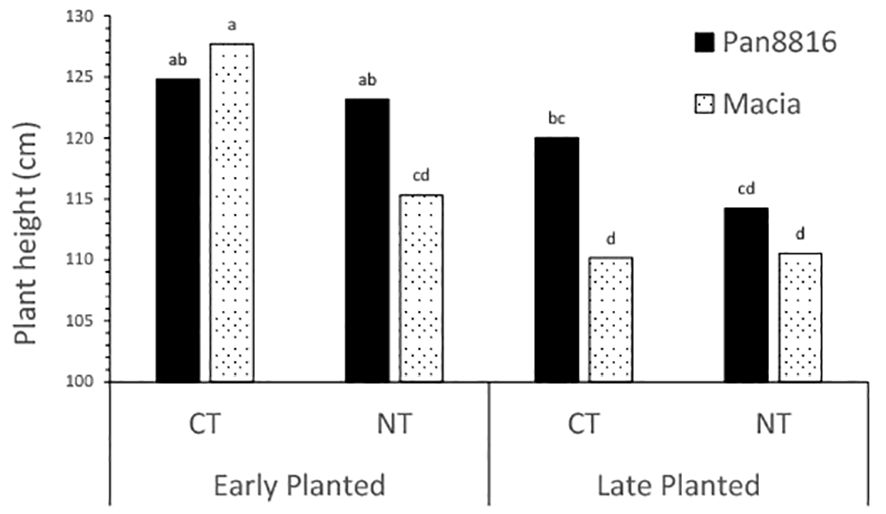
Figure 2 Effect of planting date×tillage×cultivar on plant height in FS in season 2021/22. Different letters on the bars indicate significant differences at p < 0.05.
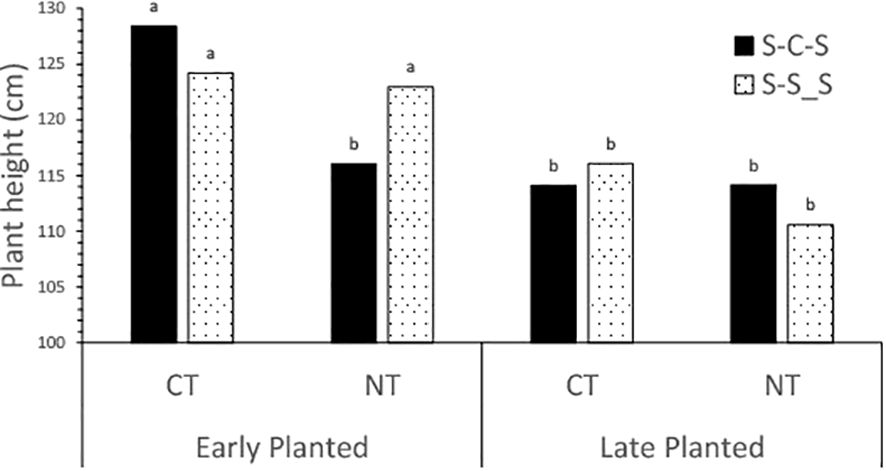
Figure 3 Effect of planting date×cultivar×rotation on plant height in in FS in season 2021/22. Different letters on the bars indicate significant differences at p < 0.05.
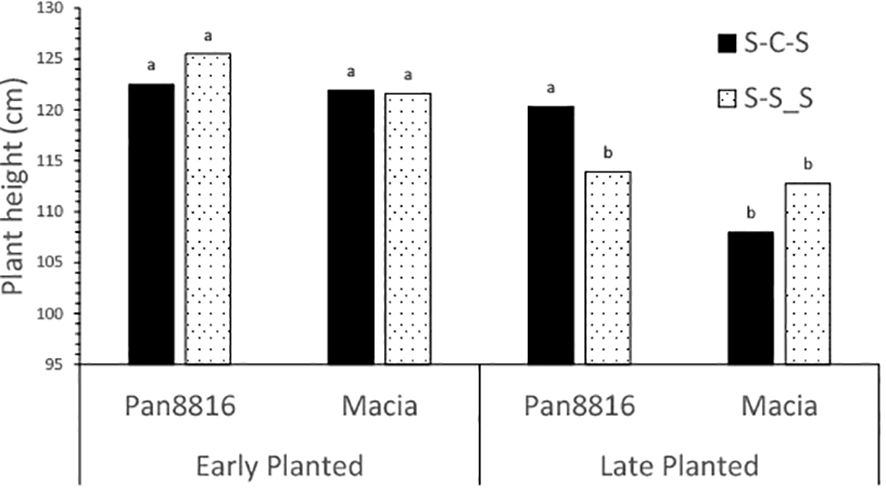
Figure 4 Effect of planting date×cultivar×rotation on plant height in FS in Season 2021/22. Different letters on the bars indicate significant differences at p < 0.05.
Only the planting date × tillage interaction had a significant effect on plant height in KZN in the first season. There were no significant tillage effects for early planted crops, while for late planting, NT resulted in taller plants than CT (Figure 5). Late planting resulted in significantly shorter plants only under CT but not under NT (Figure 5). For the second season (2021/22), the 4-way interaction effects of planting date × tillage × cultivar × rotation were significant (p<0.05) on plant height. In the second season, PAN8816 resulted in taller plants than Macia, in the sorghum-cowpea-sorghum rotation, under CT but not under NT, for both planting times (Figure 6). The PAN8816 also had taller plants than Macia, in the sorghum-sorghum-sorghum rotation under NT only when planted early, with no differences for late planting. Overall, the Pan8816 (140 cm) grew significantly taller than Macia (113 cm) in the second season (Figure 6). All the major and interactive treatment effects were not significant for 1000 seed weight and panicle length in both seasons.
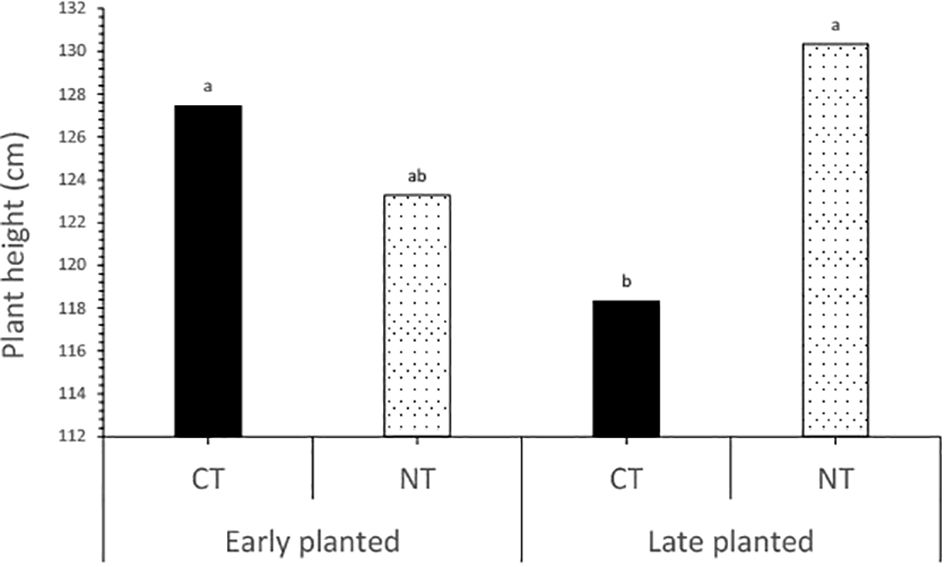
Figure 5 Effect of planting date×tillage on plant height in KZN in 2020/21. Different letters on the bars indicate significant differences at p < 0.05.
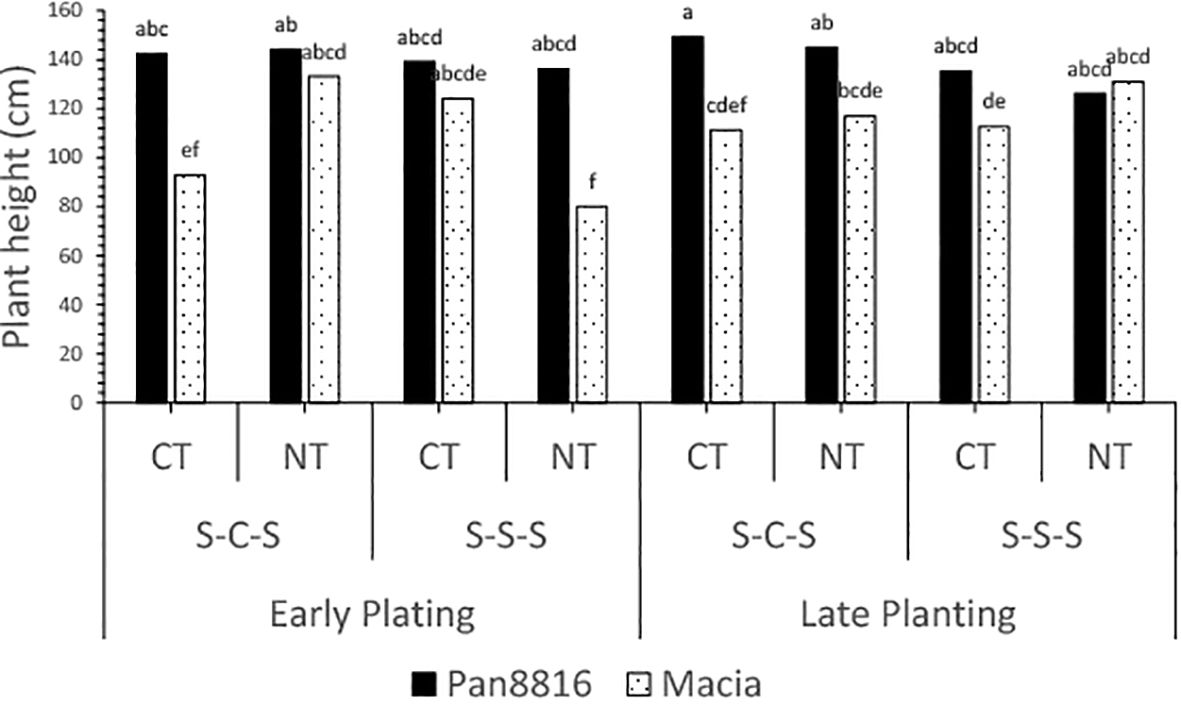
Figure 6 Effect of plating date×tillage×cultivar×rotation on plant height in KZN in season 2021/22. Different letters on the bars indicate significant differences at p < 0.05.
There were no interactive effects of PD, tillage, cultivar on yield in FS for the first season. The early planted sorghum (1.15 t/ha) had 2.66 times higher yield than late planted (0.434 t/ha) sorghum in the first season. In the second season (2021/22), early planting (3.39 t/ha) resulted in significantly (p<0.05) higher yield than late planting (0.91 t/ha), while plants grown under CT (2.61 t/ha) produced significantly higher yield than under NT (1.70 t/ha) in FS (Figure 7).
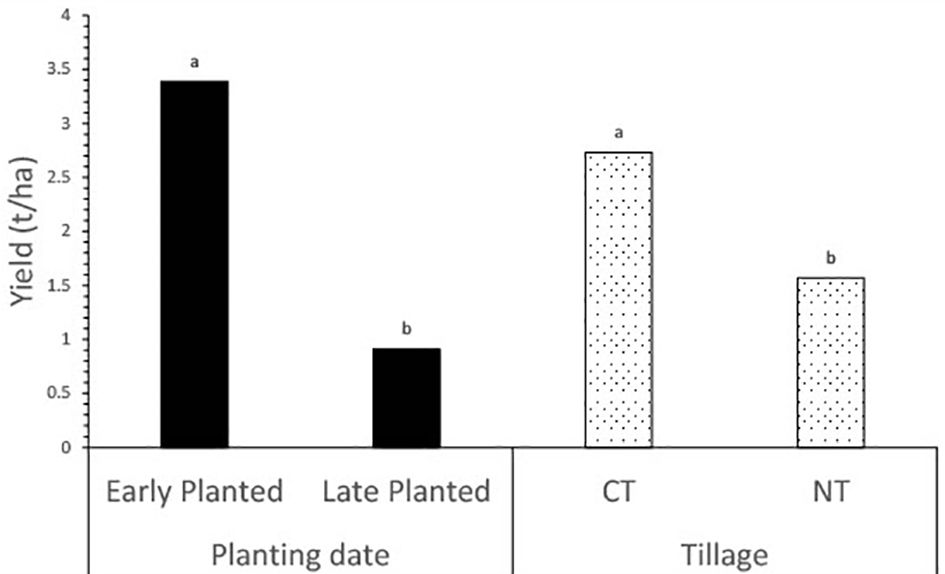
Figure 7 Effect of planting date and tillage on yield in FS in Season 2021/22. Different letters on the bars indicate significant differences at p < 0.05.
Early planting resulted in significantly (p<0.05) higher uptake of all three nutrients (Figure 8), i.e., higher N (16 kg/ha), K (15 kg/ha) and P (3 kg/ha) uptake than late planted crops. There was also a significant effect of cultivar on P uptake where Pan8816 (2.7 kg/ha) took up 1.74 times more than Macia (1.6 kg/ha). All the treatment factors had no significant (p>0.05) effects on the uptake of all the nutrients in KZN for the same season.
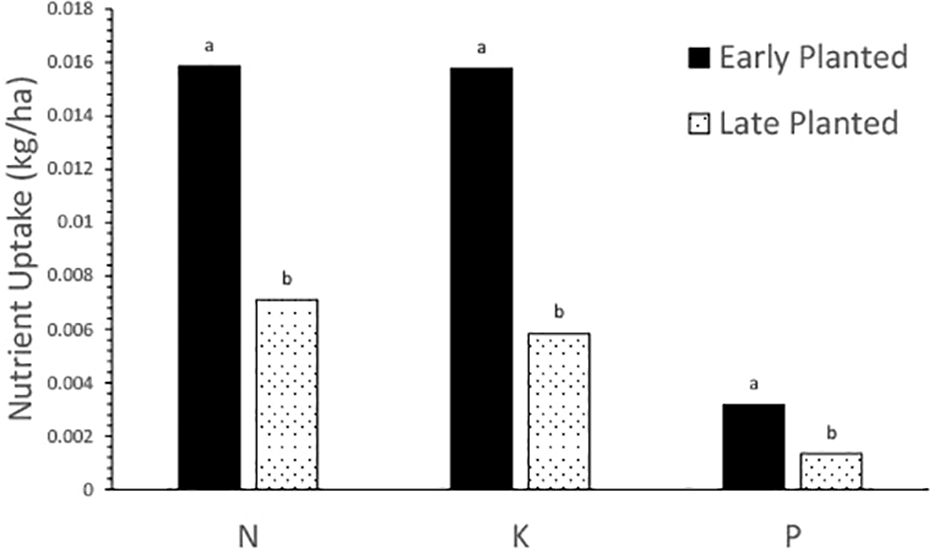
Figure 8 Effect of planting date on NPK uptake in FS in 2020/21. Different letters on the bars indicate significant differences at p < 0.05.
Plants grown under CT (17 kg/ha) took up significantly more K than those grown on NT (8 kg/ha) plots in FS, in the second season. Planting date is again the only treatment that has significant effect (P < 0.05) on all the three measured nutrients, in FS, in the 2021/22 season. Early planted sorghum took up significantly more NPK than late planted sorghum (Figure 9).
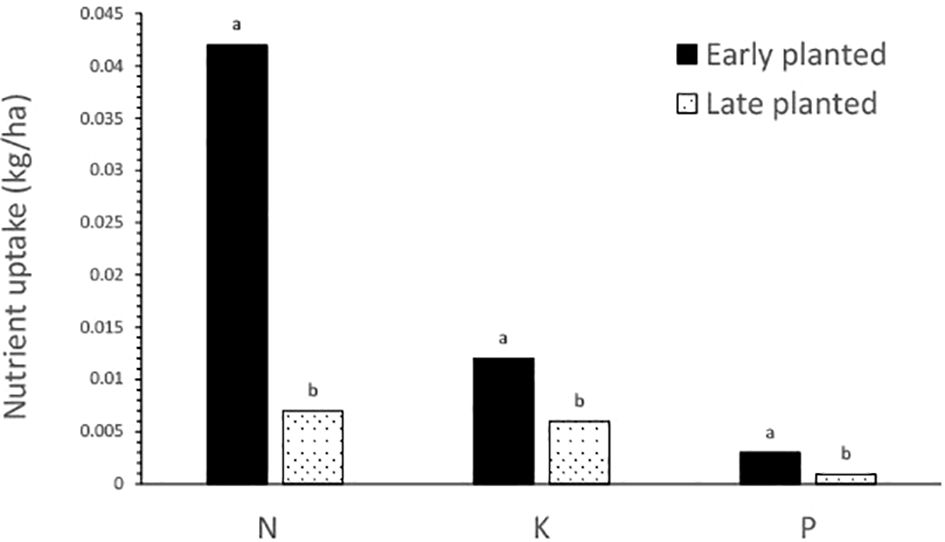
Figure 9 Effect of planting date on NPK uptake in FS in 2021/22. Different letters on the bars indicate significant differences at p < 0.05.
The interactions and main factor did not significantly affect (p>0.05) sorghum grain yield and uptake of N, P and K in KZN in both seasons, except cultivar in the second season, where Pan8816 (4.40 t/ha) produced 3.3 times higher yield than Macia (1.32 t/ha). Cultivar had a significant effect (p<0.05) of on N, P and K uptake in KZN, for both seasons, with Pan8816 having higher of N (84 kg/ha), K (64 kg/ha) and P (8 kg/ha) uptake when compared to Macia in the second season (Figure 10).
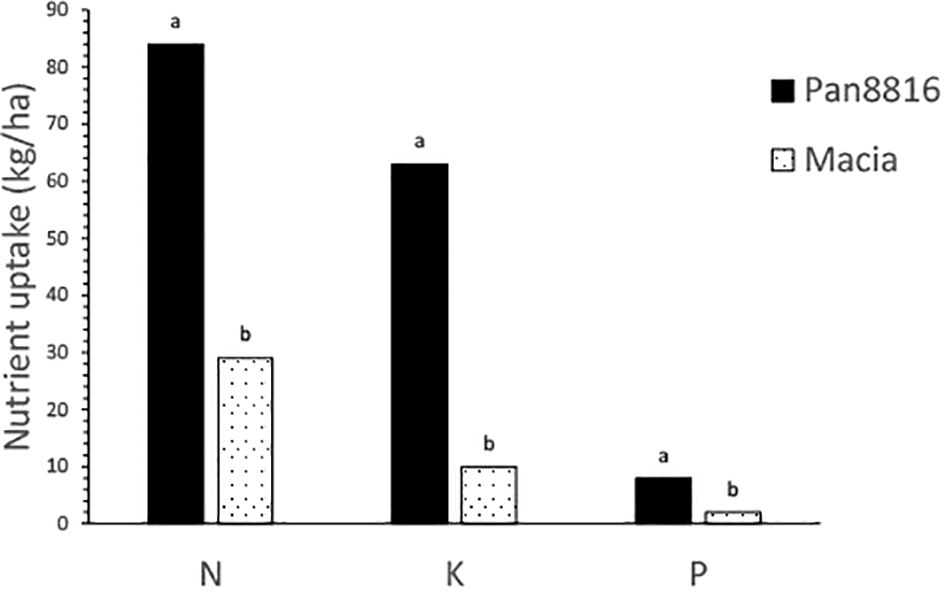
Figure 10 Effect of cultivar on N, P and K uptake in KZN in 2021/22. Different letters on the bars indicate significant differences at p < 0.05.
The planting date, cultivar and planting date × tillage factors were the most influential factors affecting plant height across all treatments. Early planted crops consistently grew taller than their late planted counterparts due to longer growing season with more conducive environmental conditions for growth such as temperature and moisture. Optimal environmental conditions positively influence plant growth (Irawan et al., 2022). This effect was particularly pronounced in the drier FS province. Early planting in FS allowed plants to benefit from availability of more soil moisture for extended periods. Conversely, the absence of significant height differences between early and late planting in KZN province, which generally receives higher rainfall, and a naturally longer growing season supports this observation. Table 1 shows that the annual rainfall of KZN (799 mm) is higher than of FS (401 mm).
Sorghum cultivar also played a role in plant height. Pan8816 consistently produced taller sorghum plants for than Macia in both seasons and locations. This suggests inherent genetic differences among the cultivars (Irawan et al., 2022). Pan8816 is a medium to late maturing hybrid while Macia is early to medium maturing open-pollinated variety (OPV) (Weepener et al., 2014; Hadebe et al., 2017). Pan8816 being a hybrid has been bred to have the best traits for a number of different parent lines while the OPV Macia only have the traits of the parent because the pollination occurs naturally. According to Gosh et al. (2015), differences in plant height among cultivars are due to genetic differences. While planting date and tillage interaction influenced plant height in KZN during the first season, cultivar and the interaction of all treatment factors had significant effects in the second season. This suggests that selecting the most appropriate cultivar, such as the taller PAN8816 in this study is more critical than time of planting in KZN under a particular set of conditions. Furthermore, regional adaptability also plays a role in the plant height of sorghum crops (Gosh et al., 2015; Sebetha and Modisapudi, 2019).
The higher yield for early planted than late planted crops in Free State in both seasons, is likely due to the longer growing season, which allows for greater biomass accumulation, flowering and grain filling. This aligns with findings by Shoyer et al. (1998) and Hadebe et al. (2017) who reported that planting after the first rains in dry to semi-arid summer grain growing regions results in much greater yields. Sorghum thrives in soil temperatures around 15°C at a depth of 10 cm (Murdy et al., 1994). However, late planting in FS coincides with the occurrence of frost, usually occurring between March and April (Moeletsi et al., 2016). These cooler temperatures impact sorghum emergence and early growth by delaying panicle initiation and flowering, ultimately reducing yield (Emendack et al., 2021). In the current study, the prevailing temperatures in FS fell below the optimal range reported by other researchers (Balota et al., 2010; Emendack et al., 2021) (Table 1). Moreover, sorghum tends to do well in warmer climates (Sebetha and Modisapudi, 2019). The higher yields observed under conventional tillage can be attributed to the relatively short period during which no-till was practised at the site. Findings by Pittelkow et al. (2015) suggested the full benefits of no-till agriculture may take up to four years to be realized. The observed similarity between yield and uptake of N, P and K, suggested that the enhanced uptake of these nutrients under conventional tillage contributed to the greater yield.
Nitrogen is the most limiting nutrient for sorghum production (Teshome et al., 2023). Tillage practices and cultivar selection can significantly affect short-term nitrogen use (Ramadhan and Mushin, 2021). In this study, conventionally tilled plots exhibited higher porosity and lower bulk density compared to NT plots. Another notable observation was the similar N and P uptake patterns across both sites. Similarly, Ortas et al. (1996) found that ammonium-based nitrogen fertilisers like monoammonium phosphate (MAP) used in this study promoted the uptake of phosphorus. Therefore, the MAP used as the pre-planting fertilizer in this study, implies greater availability of phosphorus owing to the ammonia in the MAP.
The significantly higher yield of PAN8816 compared to Macia is likely due to its greater uptake of N, P and K. This enhanced uptake could be attributed to inherent genetic differences between the cultivars. In KZN, cultivar was the most prominent factor influencing yield. Pan8816, a hybrid, has been demonstrated to have small canopy size, which allows it to maintain a higher chlorophyll content (Manyathi, 2014), which in turn translates to increased levels of photosynthesis ultimately supporting higher yields. The lack of tillage, time of planting and rotation effects in KZN could be due to the higher rainfall received in the region. This translates to greater available moisture throughout a longer growing season compared to FS.
A drawback of this short-term study is the potential for increased competition between sorghum crops and weeds for vital resources such as nutrients and moisture (Giller et al., 2009). Despite applications of pre-planting and post-planting herbicides, significant weed presence was observed at both sites. Short-term studies can also be susceptible to challenges like poor germination, higher prevalence of crop pests and nutrient immobilization (Giller et al., 2009). These challenges arise due to the complex interaction between crop requirements, climate and soil characteristics. For instance, the presence of plant residues can cause temporary nutrient immobilization by soil microbes especially when the climatic conditions allow (Dabeux and Sollenberger, 2020).
This study identified key factors influencing sorghum performance in some parts of FS and KZN. In FS, planting date and cultivar, significantly influenced plant height, yield and nutrient uptake. Early planting and selection on PAN8816 cultivar is the most favorable combination to avoid frost and maximize yield. In KZN, cultivar was the primary factor, influencing yield, with Pan8816 outperforming Macia. However, planting date had minimal impacts in KZN, suggesting a greater flexibility for farmers. Therefore, farmers at the KZN site can plant sorghum across the tested dates without significant yield penalties. Early planting is recommended for FS to avoid the frost season. Additionally, PAN8816 is recommended at both sites, especially under conventional tillage. However, longer-term studies are necessary to determine the influence of no-till practices, as the benefits may not be realized within the two-season timeframe of this study.
The raw data supporting the conclusions of this article will be made available by the authors, without undue reservation.
KM: Data curation, Formal Analysis, Investigation, Methodology, Software, Writing – original draft. AN: Conceptualization, Funding acquisition, Investigation, Project administration, Resources, Supervision, Validation, Writing – review & editing. PM: Conceptualization, Investigation, Project administration, Resources, Supervision, Validation, Writing – review & editing.
The author(s) declare financial support was received for the research, authorship, and/or publication of this article. Department of agriculture, land reform and rural development. Grant number 21/1.1.1/19/CCDM – 01/ISCW.
The authors would like to acknowledge Hlayisani Z Mabasa, the University of KwaZulu Natal, ARC-NRE and the Department of Agriculture Land Reform and Rural Development for their contribution to the research toward this manuscript.
The authors declare that the research was conducted in the absence of any commercial or financial relationships that could be construed as a potential conflict of interest.
All claims expressed in this article are solely those of the authors and do not necessarily represent those of their affiliated organizations, or those of the publisher, the editors and the reviewers. Any product that may be evaluated in this article, or claim that may be made by its manufacturer, is not guaranteed or endorsed by the publisher.
Aziz I., Mahmood J., Islam R. K. (2013). Effect of long term no till and conventional tillage practices on soil quality. Soil tillage Res. 131, 119–129. doi: 10.1016/j.still.2013.03.002
Bakari H., Djomdi, Ruben Z. F., Roger D. D., Cedric D., Guillame P., et al. (2023). Sorghum (Sorghum bicolor L. Moench) and its main parts (by-products) as promising sustainable sources of value added ingredients. Waste Biomass Valorization 14, 1023–1044. doi: 10.1007/s12649-022-01992-7
Balota M., Payne W. A., Veeragoni S. K., Sterwart B. A., Rosenow D. T. (2010). Repiration and its relationship to emergence and early growth under cool temperatures in sorghum. Crop Sci. 55, 1414–1422. doi: 10.2135/cropsci2009.08.0448
Beretta A. N., Silbermann A. V., Paladino L., Torres D., Bassahun D., Musselli R., et al. (2014). Soil texture analyses using a hydrometer: Modification of the Bouyoucos method. Cien. Inv. Agr. 41 (2), 263-271. doi: 10.4067/S0718-16202014000200013
Busari M. A., Kukal S. S., Kaur A., Bhatt R., Dulazi A. A. (2015). Conservation tiilage effects on soil, crop and the environment. Int. Soil Water Conserv. Res. 3, 119–129. doi: 10.1016/j.iswcr.2015.05.002
Choudhary M., Ghasal P. C., Kumar S., Yadav R. P., Singh S., Meena V. S., et al. (2016). “Chapter 1: Conservation agriculture and climate change: An overview,” in Conservation agriculture. Eds. Bisht J. K., Meena V. S., Mishra P. K., Pattanayak A. (Singapore: Springer).
Dabeux J. C. B., Sollenberger L. E. (2020). “Nutrient cycling in grazed pastures,” in Mangement strategies for sustainable cattle production in southern pastures, vol. 2020. Eds. Pas M. R., Aiken G. E. (United States: Academic Press).
Emendack Y., Sanchez J., Hayes C., Nesbitt M., Laza H., Burke J. (2021). Seed-to-seed early-season cold resiliency in sorghum. Sci. Rep. 11, 7801. doi: 10.1038/s41598-021-87450-1
Fischer G., Frohberg K., Parry M., Rosenzweig C. (1996). “19. The potential effects of climate change on world food production and security,” in Global climate change and agricultural production: Direct and indirect effects of a changing hydrological, pedological and plant physiological processes. Eds. Bazzaz F., Sombroek W. (New York: FAO and John Wiley & Sons).
Giller K. E., Witter E., Corbeels M., Tittonell P. (2009). Conservation agriculture and smallholder farming in Africa: The Heretics’ view. Field Crops Reasearch 114, 23–34. doi: 10.1016/j.fcr.2009.06.017
Gomez K. A., Gomez A. A. (1984). Statistical procedures for agricultural research. 2nd ed (New York: Wiley).
Gornall J., Betts R., Burke E., Clark R., Camp J., Willet K., et al. (2010). Implications of climate change for agricultural productivity in the early twenty-first century. Philos. transaction R. Soc. B 365, 2973–2989. doi: 10.1098/rstb.2010.0158
Gosh S. C., Akram S., Ahsan S. M., Al-Asif A., Shahriyar S. (2015). Morpho-Physical and yield performance of grain sorghum genotypes. Asian J. Med. Biol. Res. 1, 271–284.
Hadebe S. T., Mabhaudi T., Modi A. T. (2017). Water use of Sorghum (Sorghum bicolor L Moench) in response to varying planting dates evaluated under rainfed conditions. Water SA 42. doi: 10.4314/wsa.v43i1.12
Hobbs P. R., Sayre K., Gupta R. (2008). The role of conservation agriculture in sustainable agriculture. Philos. Trans. R. Soc. B 363, 543–555. doi: 10.1098/rstb.2007.2169
Ikazaki K., Nagumo F., Simpore S., Iseki K., Barro A. (2020). Effects of intercropping component of conservation agriculture on sorghum yield in the Sudan Savanna. Soil Sci. Plant Nutr. 66 (5), 755-762. doi: 10.1080/00380768.2020.1816444
Irawan F. Y., Al’jumiati W. O., Pasau C., Asminaya N. S., Nurlaha (2022). Potential development of sorghum plants (sorghum bicolor L Moench) as alternative animal feed on South Konawe Regency. Adv. Biol. Sci. Res. 20. doi: 10.2991/absr.k.220309.064
JMP Statistical Discovery LLC (2022). JMP®17 Automation Reference (Cary, NC: JMP Statistical Discovery LLC).
Lal R. (2013). Food security in a changing climate. Ecohydrology hydrobiology 13, 8–21. doi: 10.1016/j.ecohyd.2013.03.006
Lal R. (2019). Promoting “4 per thousand” and Adapting African agriculture by south south corperation: Conservation agriculture and sustainable intensification. Soil Tillage Res. 188, 27–34. doi: 10.1016/j.still.2017.12.015
Manyathi T. (2014). Water productivity of selected Sorghum varieties. MSc dissertation, KwaZulu Natal: UKZN.
Masipa T. S. (2017). The impact if climate change on food security on South Africa. Current realities and challenges ahead. J. Disaster Risk Manage. 9 (1), 411. doi: 10.4102/jamba.v9i1.411
Meki M. N., Kemanian A. R., Potter S. R., Blumenthal J. M., Williams J. R., Gerik T. J. (2013). Cropping system effects on sorgum growth yield, soil organic carbon, and global warming potential in central and south Texas. Agric. Syst. 117, 19–29. doi: 10.1016/j.agsy.2013.01.004
Moeletsi M. E., Tongwane M., Tsubo M. (2016). The study of frost occurrence in Free State Province of South Africa. Adv. Meteorology 2016. doi: 10.1155/2016/9586150
Murdy D. S., Tabo R., Ajayi O. (1994). Sorghum hybrid seed production and management. ICRISAT Inf. Bull. 41.
Muthelo D., Owusu-Sekyere E., Ogundeji A. A. (2019). Smallholder farmers’ adaptation to drought: Identifying effective adaptive strategies and measures. Water 11, 2069. doi: 10.3390/w11102069
Ortas I., Harris P. J., Rollew D. L. (1996). Enhanced uptake of phosphorus by mycorrhorizal sorghum plants as influenced by forms of nitrogen. Plant Soil 184, 255–264. doi: 10.1007/BF00010454
Pinzi S., Dorado M. P. (2011). “Chapter 4: Vegetable-based feedstocks for biofuels production,” in Handbook of biofuels production. Proccesses and technologies. Eds. Laque R., Campelo J., Clark J. (Cambride: Woodhead), 61–94.
Pittelkow C. M., Linquit B. A., Lundy M. E., Liang X., van Groenigen K. J., Lee J., et al. (2015). Went does no-till yield more? A global meta-analysis. Field Crops Res. 183, 156–168. doi: 10.1016/j.fcr.2015.07.020
Ramadhan M., Mushin S. (2021). Evaluation of the response of sorghum to tillage systems and nitrogen fertilization. Int. J. Agron. 2021. doi: 10.1155/2021/6614962
Sebetha E., Modisapudi S. (2019). Effect of Nitrogen fertilizer source, soil type and season on growth performance of two sorghum cultivars. Asian J. Plant Sci. 18, 175–180. doi: 10.3923/ajps.2019.175.180
Shoyer J., Kok H., Fjell D. (1998). Seedbed preparation and planting practices (Manhattan Kansas: Kansas State University Experiment Station And Extension Services).
Soga M., Gaston K. J. (2018). Shifting baseline syndrome: Causes, consequences, and implications. Front. Ecol. Environ. 16, 222–230. doi: 10.1002/fee.1794
Teshome H., Molla E., Fesiya T. (2023). Identification of yield-limiting nutrients for sorghum (Sorghum bicolor (L.) moench) yield, nutrient uptake and use efficiency on vertisols of raya kobo district, northeastern Ethiopia. Int. J. Agron. 2023. doi: 10.1155/2023/5394806
Thierfelder C., Wall P. C. (2012). Effectos of conservation agriculture on soil quality and productivity in contrasting agro-ecological of Zimbabwe. Soil Use Manage. 28, 209–220. doi: 10.1111/j.1475-2743.2012.00406.x
Toliver D. K., Larsson J. A., Roberts R. K., English B. C., de la Torre Ugarte D. G., West T. O. (2012). Effects of No-Till on yields as influenced by crop and environmental factors. Agron. J. 104, 530–541. doi: 10.2134/agronj2011.0291
van Huyssteen C. W. (2020). Relating the South African soil taxonomy to the world reference base for soil resources (Bloemfontein: Sunbonani scholar). doi: 10.18820/9781928424666
Van Reeuwijk L. P. (2002). Procedures for soil analysis, 6th edition-technical paper-ISRIC (the Netherlands: Wageningen).
Wakindiki I. I. C., Malobane M. E., Nciizah A. D. (2018). “Integrating biofertilizers with conservation agriculture can enhance its capacity to mitigate climate change: Examples from Southern Africa,” in University Initiatives in Climate Change Mitigation and Adaptation. Eds. Leal Filho W., Leal-Arcas R. (Switzerland: Springer).
Wang X., Wang J., Zangh J. (2012). Comparisons of three methods of for organic and inorganic carbon in calcareous soil of north-western China. PloS One 7. doi: 10.1371/journal.pone.0044334
Weepener H. L., Engelbrecht C. J., Carstens J. P. (2014). Sensitivity of crop suitability in South Africa to climate change. (South Africa: Department of Agriculture, Forestry and Fisheries, Directorate).
Wright A. F., Bailey J. S. (2001). Organic carbon, total carbon, and total nitrogen determinations in soil of variable calcium carbonate contents using a Leco CN-2000 (New York: Marcel Dekker, Inc.).
ZDM (2018). Spatial development framework (Zululand district municipality: Cooperative governance and traditional affairs).
Keywords: conservation agriculture, climate change, food security, small-scale famers, sub-Saharan Africa
Citation: Mrubata K, Nciizah AD and Muchaonyerwa P (2024) Planting date and tillage effects on yield and nutrient uptake of two sorghum cultivars grown in sub-humid and semi-arid regions in South Africa. Front. Agron. 6:1388823. doi: 10.3389/fagro.2024.1388823
Received: 20 February 2024; Accepted: 21 May 2024;
Published: 05 June 2024.
Edited by:
Ivan Vasenev, Moscow Timiryazev Agricultural Academy, RussiaReviewed by:
Corina Carranca, National Institute for Agricultural and Veterinary Research (INIAV), PortugalCopyright © 2024 Mrubata, Nciizah and Muchaonyerwa. This is an open-access article distributed under the terms of the Creative Commons Attribution License (CC BY). The use, distribution or reproduction in other forums is permitted, provided the original author(s) and the copyright owner(s) are credited and that the original publication in this journal is cited, in accordance with accepted academic practice. No use, distribution or reproduction is permitted which does not comply with these terms.
*Correspondence: Kaya Mrubata, bXJ1YmF0YWtAYXJjLmFncmljLnph; MjIxMTIwMDg3QHN0dS51a3puLmFjLnph
Disclaimer: All claims expressed in this article are solely those of the authors and do not necessarily represent those of their affiliated organizations, or those of the publisher, the editors and the reviewers. Any product that may be evaluated in this article or claim that may be made by its manufacturer is not guaranteed or endorsed by the publisher.
Research integrity at Frontiers

Learn more about the work of our research integrity team to safeguard the quality of each article we publish.